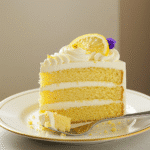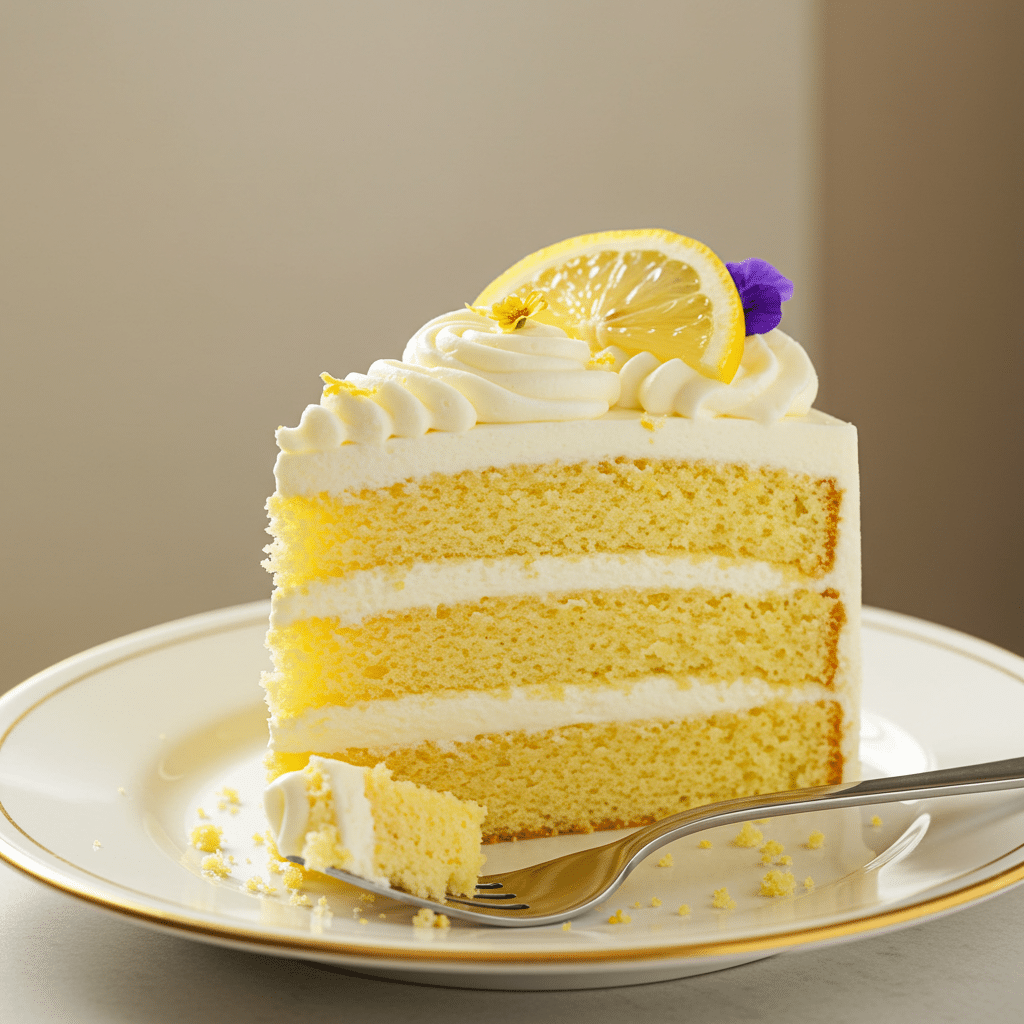A delicious lemon Chantilly cake offers the perfect balance of citrus brightness and creamy indulgence. With soft lemon-infused layers and cream cheese buttercream frosting, it is a dessert that feels both light and luxurious. Olive oil adds depth and moisture, while lemon curd provides bursts of tang between layers.
This cake is ideal for spring gatherings, birthdays, and elegant celebrations. In this article, you will discover how the flavors blend, which ingredients matter most, the preparation process, decorating ideas, and serving tips to ensure your lemon Chantilly cake always delights.
The Balance of Lemon and Cream
Why Lemon Works in Cakes
Lemon infuses desserts with freshness and brightness. Zest adds fragrant oils, while juice introduces tang that keeps the sponge from feeling heavy. This balance enhances sweetness and ensures the cake remains refreshing. Lemon also contrasts beautifully with creamy fillings, making it a favorite in layered cakes. Like citrus in a moist flavorful citrus olive oil cake, lemon elevates simple ingredients into something memorable.
📄 Want to keep this recipe for later? Download your printable PDF version now and start cooking anytime!
📥 Download Recipe PDF✅ Print-friendly • 🕒 Save for later • 📱 Mobile-accessible
💡 Want more like this? Subscribe for weekly printable recipes!
The Role of Cream in Chantilly Cakes
Chantilly often refers to sweetened cream or whipped frostings, but in this cake, it expands to a cream cheese buttercream. The tang of cream cheese pairs with butter’s richness, while powdered sugar brings sweetness. This frosting balances the lemon sponge with silky texture, creating harmony in every bite.
Print
Delicious Lemon Chantilly Cake
- Total Time: 1 hour
- Yield: 10–12 servings 1x
- Diet: Vegetarian
Description
A delicious lemon Chantilly cake with bright citrus sponge layers and cream cheese buttercream frosting. Perfect for celebrations and refreshing summer desserts.
Ingredients
— For the Lemon Chantilly Cake —
3 cups cake flour or all-purpose flour
Zest of 2 lemons
1/3 cup freshly squeezed lemon juice (about 1–2 lemons)
1 1/4 cups granulated cane sugar
2 1/2 tsp baking powder
1/4 tsp baking soda
1/2 tsp fine sea salt
8 tbsp unsalted butter, softened
1/2 cup olive oil
3 large eggs, room temperature
1 1/2 cups whole milk, room temperature
2 tsp vanilla extract
— For the Cream Cheese Buttercream Frosting —
1/2 cup unsalted butter, softened
8 oz cream cheese
4 cups powdered sugar
1 1/2 tsp vanilla extract
1/8 tsp fine salt
1 tbsp heavy whipping cream
Yellow food coloring (optional)
1/2 cup lemon curd (optional)
Instructions
1. Preheat oven to 350°F. Grease and line two 8-inch pans.
2. Rub lemon zest into sugar until fragrant. Beat with butter for 2 minutes.
3. Add eggs and beat until doubled in volume.
4. Mix in lemon juice, olive oil, vanilla, and milk.
5. Combine flour, baking powder, baking soda, and salt in a bowl. Add to wet mixture. Whisk gently until smooth.
6. Divide batter between pans and bake 25–30 minutes. Cool 10 minutes, then transfer to racks.
7. For frosting, beat butter and cream cheese until smooth. Add powdered sugar gradually, then vanilla, salt, and cream. Whip until fluffy.
8. Layer cake with frosting and lemon curd. Frost exterior and decorate with zest or lemon slices.
Notes
Use mild olive oil for best flavor.
Bake layers one day in advance for deeper taste.
Store frosted cake in fridge up to 4 days.
Freeze unfrosted layers up to 2 months.
- Prep Time: 30 minutes
- Cook Time: 30 minutes
- Category: Dessert
- Method: Baking
- Cuisine: American
Nutrition
- Serving Size: 1 slice
- Calories: 410
- Sugar: 35g
- Sodium: 220mg
- Fat: 22g
- Saturated Fat: 12g
- Unsaturated Fat: 8g
- Trans Fat: 0g
- Carbohydrates: 46g
- Fiber: 1g
- Protein: 5g
- Cholesterol: 95mg
Essential Ingredients
Building the Sponge
The sponge uses flour, sugar, butter, olive oil, eggs, and milk. Cake flour ensures tenderness, while sugar locks in moisture. Butter enriches flavor, and olive oil keeps the crumb soft. Eggs add structure, and milk lightens the batter. Baking powder and baking soda provide rise, while salt sharpens flavors.
The star ingredients are lemon zest and juice. Rubbing zest into sugar releases oils that perfume the batter, while juice brings tang. This combination guarantees a sponge that feels vibrant and aromatic.
Creating the Frosting
The frosting blends butter, cream cheese, powdered sugar, vanilla, salt, and cream. Butter and cream cheese create smoothness, sugar stabilizes, and cream lightens. Vanilla enhances flavor, while salt balances sweetness. Optional food coloring adds presentation, and lemon curd between layers intensifies citrus notes.
Preparing the Batter
Infusing Lemon Flavor
Start by rubbing lemon zest into sugar to extract essential oils. The sugar becomes fragrant and flavorful. Beating butter with this mixture ensures lemon permeates the batter. Adding eggs introduces air, increasing volume and making the sponge fluffy.
Whisk in lemon juice, olive oil, vanilla, and milk. These wet ingredients provide richness and brightness. Their combination gives the cake a moist yet airy texture.
Combining Dry and Wet Ingredients
Mix flour, baking powder, baking soda, and salt separately to ensure even distribution. Add dry ingredients to the wet mixture gradually. Whisk gently until just smooth. Overmixing can make the sponge dense, so stop as soon as the flour disappears. Divide batter evenly between lined pans for consistent baking.
Baking and Cooling
Achieving Even Layers
Bake at 350°F for 25–30 minutes, or until a toothpick comes out clean. Rotate pans halfway through to ensure even cooking. The cakes should rise evenly and turn golden. Avoid overbaking, which dries the sponge, or underbaking, which leaves the center gummy.
Even layers make assembly smoother. If needed, trim domed tops with a serrated knife to create flat surfaces for stacking.
Cooling for Frosting
Cool cakes in pans for 10 minutes, then transfer to wire racks. Let them cool completely before frosting. For easier slicing, chill layers briefly in the refrigerator. You can also bake a day in advance, wrap layers tightly, and refrigerate. This improves flavor and makes frosting easier.
Making the Cream Cheese Frosting
Blending the Base
Beat butter and cream cheese until smooth and creamy. Add powdered sugar gradually, then mix in vanilla, salt, and cream. Whip until fluffy and spreadable. The frosting should hold its shape but spread easily. If too stiff, add a splash of cream; if too soft, chill briefly.
Adding a Citrus Twist
For extra lemon flavor, add zest and juice directly into the frosting. This creates a tangy, vibrant topping that pairs beautifully with the sponge. Yellow food coloring can enhance the look, but it is optional. Lemon curd between layers intensifies the citrus theme and adds variety in texture.
Assembling the Cake
Layering and Filling
Place one cake layer on a stand. Spread frosting evenly across, then add a thin layer of lemon curd if using. Repeat with remaining layers. Alternate between frosting and curd to create balance. This method gives each slice bursts of citrus alongside creamy frosting.
Ensure layers are level and aligned. If cakes have domed tops, trim them before stacking. This prevents leaning and helps the cake look professional.
Frosting and Decorating
Apply a crumb coat to lock in crumbs, then chill for 20 minutes. Spread a final frosting layer, smoothing with a spatula or creating swirls for a rustic finish. Garnish with lemon slices, zest curls, or edible flowers for elegance. Simple decoration highlights the bright yellow theme.
Serving and Storage
Serving Suggestions
Serve at room temperature for best flavor and texture. Pair with tea, lemonade, or sparkling water. The refreshing lemon makes it suitable for brunch, birthdays, or spring events. Each bite delivers light sponge, tangy frosting, and optional lemon curd for extra zing.
The cake suits both casual and formal occasions. Its appearance and flavor make it versatile for many celebrations.
Storage Tips
Store frosted cake in an airtight container in the refrigerator for up to four days. Bring slices to room temperature before serving. Freeze unfrosted layers for up to two months, tightly wrapped. Thaw overnight in the fridge before frosting. For freezing frosted cake, slice and wrap individually for easy servings later.
Tips and Variations
Flavor Options
Swap lemon with lime or orange for different citrus profiles. Add poppy seeds to the batter for texture. Drizzle glaze over frosting for added sweetness.
For a floral note, mix lavender or rose extract into frosting. These variations let you customize the cake for seasons or special events.
Dietary Adjustments
Use a gluten-free flour blend for a gluten-free version. Reduce powdered sugar for a lighter frosting. Plant-based cream cheese and butter make it vegan-friendly. Olive oil already adds dairy-free moisture, making adaptation easier.
Frequently Asked Questions
Can I make this cake ahead?
Yes, bake sponge layers a day ahead, refrigerate, and frost the next day. This helps flavors develop and makes assembly easier.
Do I need lemon curd?
No, the frosting alone works. Curd adds extra citrus but is optional.
What type of olive oil works best?
A light, mild olive oil is best. Strong oils can overpower lemon flavor.
Why did my cake turn dense?
Overmixing after adding flour can make the sponge heavy. Mix only until just combined.
Can I freeze the cake?
Yes, wrap slices individually before freezing. Thaw overnight in the fridge before serving.
Conclusion
A delicious lemon Chantilly cake combines the brightness of lemon with the richness of cream cheese frosting. Olive oil and butter create a moist crumb, while zest and juice infuse the sponge with citrus fragrance. Optional lemon curd intensifies flavor, creating a dessert that feels both refreshing and indulgent. With simple preparation and versatile decoration, this cake suits any occasion. Once you try it, the balance of citrus and cream will make it a regular favorite.

